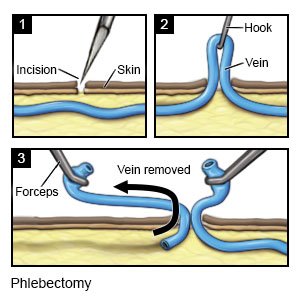Phlebectomy
Medically reviewed by Drugs.com. Last updated on Aug 4, 2025.
What do I need to know about phlebectomy?
Phlebectomy is a procedure to remove varicose veins close to the surface of your skin.
How do I prepare for phlebectomy?
- Your healthcare provider will tell you how to prepare. Arrange to have someone drive you home when you are discharged.
- Tell your provider about all medicines you currently take. Your provider will tell you if you need to stop any medicine for the procedure, and when to stop. Your provider will tell you which medicines to take or not take on the day of your procedure.
- Tell your provider about any allergies you have, including to local anesthesia.
Related medications
What will happen during phlebectomy?
You will be given local anesthesia to numb the procedure area. With local anesthesia, you may still feel pressure or pushing, but you should not feel any pain. Your healthcare provider will make small punctures or incisions in the skin near the veins. Your provider will use clamps or a small hook to grab the vein and remove it. The incisions may be closed with skin adhesive glue or tape. Your provider will apply a pressure dressing to the area.
 |
What should I expect after phlebectomy?
You will be able to get up and walk around right after the procedure. You will be able to go home the same day. Keep the pressure dressing on as long as directed. Change the dressing as directed.
What are the risks of phlebectomy?
You may bleed or bruise more than expected or develop an infection. You may develop a blood clot. You may have a skin reaction such as a rash or ulcer.
Care Agreement
You have the right to help plan your care. Learn about your health condition and how it may be treated. Discuss treatment options with your healthcare providers to decide what care you want to receive. You always have the right to refuse treatment. The above information is an educational aid only. It is not intended as medical advice for individual conditions or treatments. Talk to your doctor, nurse or pharmacist before following any medical regimen to see if it is safe and effective for you.© Copyright Merative 2025 Information is for End User's use only and may not be sold, redistributed or otherwise used for commercial purposes.
Further information
Always consult your healthcare provider to ensure the information displayed on this page applies to your personal circumstances.
